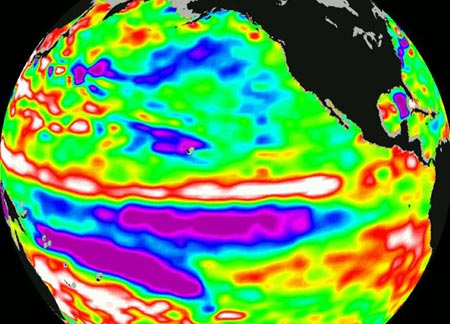Can predict the phenomenon of El Nino earlier
According to the Natural Geological Science magazine on February 21, weather experts were able to predict the El Nino phenomenon before 14 months, much earlier than just a few months ago.
Based on weather records from 1981 to 2009, meteorologists at the Global Climate Change Research Institute in Yokohama, Japan, discovered when the so-called bipolar phenomenon in the Indian Ocean entering the "negative" stage, which indicates that the water in the West warms up while in the East it cools, the El Nino phenomenon may appear in the Pacific Ocean more than two years later.

Scientists believe that the atmospheric circulation between the two oceans is responsible for the link between bipolarism in the Indian Ocean and the El Nino phenomenon in the Pacific.
El Nino appears every 2 to 7 years, when the Pacific island winds begin to weaken, creating a warm water area on the West Bank, then overflowing to the East Coast.
Fluctuations in water temperature lead to a dramatic change in precipitation, often flooding and causing landslides in the drylands of Southwest America and drought in the Western Pacific, as well as changes in Nutrient-rich ocean currents for fish species.
The ability to predict El Nino late in the past caused farmers, fishermen and many other industries to not have enough time to deal with weather disorders.
- El Nino 2015 looks strange with the peak of 1997
- New technology to detect early El Niño phenomenon
- El Nino weather phenomenon may soon appear
- El Nino is about to end in the Caribbean
- El Nino is getting worse due to rising temperatures
- Predict the hot sun record in 2014
- El Nino phenomenon appeared again silently
- NASA: We are experiencing the peak of El Nino
- What is La Nina phenomenon?
- There is no link between El Nino and climate change
- El Nino changes may cause many storms to land
- Seabirds can predict El Nino
 Is the magnetic North Pole shift dangerous to humanity?
Is the magnetic North Pole shift dangerous to humanity? Washington legalizes the recycling of human bodies into fertilizer
Washington legalizes the recycling of human bodies into fertilizer Lightning stone - the mysterious guest
Lightning stone - the mysterious guest Stunned by the mysterious sunset, strange appearance
Stunned by the mysterious sunset, strange appearance